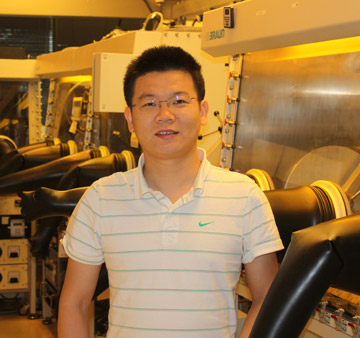Imagine powering your cell phone by leaving it on the window sill. Sounds like science fiction? Actually, this might soon turn into reality. Scientists have been exploring the potential of solar energy for decades. One of the cheapest ways to turn solar energy into electricity is by creating solar cells from organic polymers, which are easily manipulated by scientists. However, such cells are not efficient at converting sunlight to electricity. But now, researchers at UCLA’s Department of Materials Science and Engineering have come up with a new type of solar cell that sets the record in changing sunlight into power.
Many organic solar cells are single-layer—they contain a film-thin layer of the organic polymer between two transport layers. When photons strike the cell, they energize electrons, turning them into excitons. The energy in excitons can be converted to electricity. The reason why such cells are not efficient at the sun-to-electricity conversion is because the polymer only absorbs a part of the solar spectrum—a certain bandgap—not all of it. This means that much of the solar energy, which could be potentially turned into electricity, is lost.
 Jing-Bi You. |
Then researchers created the “tandem” cell. This device has two layers of organic polymers, connected by an electrically-conductive interconnecting layer. The two organic layers capture light from different parts of the solar spectrum, resulting in more light captured and less wasted—a single-layer cell has conversion efficiency of 6% while for a tandem cell, this number is 8.62%. The UCLA team that created the cell, including Jing-Bi You, Letian Dou, and Gang Li working under the supervision of Professor Yang Yang, has published its research in a recent issue of Nature Photonics. Afterwards, solar energy received another boost when Sumitomo Chemical of Japan created a polymer capable of absorbing wavelengths in the infrared spectrum. When researchers incorporated this polymer into their tandem cell, their conversion efficiency jumped to 10.6%, a new record.
“Devices with more than 10% efficiency,” says co-author Jing-Bi You, “could be incorporated into the products” that are commercially viable. For example, such cells can be used to provide electricity for cars, buildings, even planes.
“We also can make semi-transparent organic solar cell and put it on windows,” adds the paper’s co-author Letian Dou. “Then we will have colorful windows that can generate electricity during the daytime.”
However, such feats might be a while away. For now, scientists are only able to produce cells that have the maximum area of 1 cm2—definitely way too small to power a plane. But they are working hard to overcome this and other challenges so to that one day, we’ll just be able to charge our phones as we are strolling through a park on a nice day.
Related articles
Germany proves the promise of renewable energy: hits 20 percent renewables
(09/06/2011) As many people in the United States question whether renewable energy is a viable alternative to fossil fuels, Germany now derives 20.8 percent of its electricity from renewable sources—a 15 percent increase since 2000, reports Der Spiegel. In contrast, the United States generates only 10 percent of its electricity from renewable sources, 6 percent of which comes from hydroelectric power, which some environmentalists see as unacceptably damaging.
Clean energy investments rise 630% in 7 years
(03/29/2011) According to a report by the US Pew Environment Group global clean energy investments, which do not include nuclear power, jumped 630% since 2004. The report detailing 2010 clean energy investments found that China remains the global leader in clean energy, while the US fell from 2nd to 3rd. This is the second year in a row that the US fell: in 2009 it lost first place to China. In all $243 billion were invested in clean energy in 2010.
Is Obama’s clean energy revolution possible?
(01/26/2011) Last night US President Barack Obama called for a massive green energy make-over of the world’s largest economy. Describing the challenge as ‘this generation’s Sputnik moment’ the US president set a goal of producing 80 percent of America’s energy by clean sources by 2035. While this may sound improbable, two recent analyses back the president up, arguing that a global clean energy revolution is entirely possible within a few decades using contemporary technology and without breaking the bank. “Based on our findings, there are no technological or economic barriers to converting the entire world to clean, renewable energy sources,” Mark Z. Jacobson, a professor of civil and environmental engineering at Stanford said in a press release. “It is a question of whether we have the societal and political will.”
U.S. Department of Energy makes $1.5B loan to massive solar plant
(12/30/2010) The U.S. Department of Energy has finalized a guarantee to provide a loan of $1.45 billion to Abengoa Solar Inc. which will fund the world’s largest parabolic trough concentrating solar plant. The plant is expected to serve 70,000 households and avoid 475,000 tons of carbon dioxide emissions per year.
Bill Gates: ban coal and invest in clean energy technology
(02/12/2010) The planet needs “energy miracles” to overcome the dual challenges of meeting energy demand and addressing climate change, said Microsoft founder Bill Gates during a speech Friday at the TED Conference in Long Beach, California.